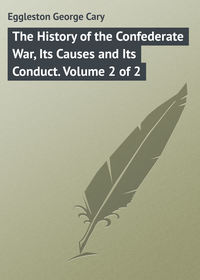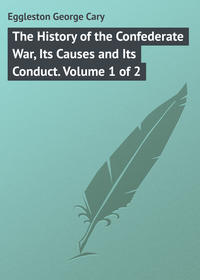 полная версия
полная версияRed Eagle and the Wars With the Creek Indians of Alabama.
Thus ended the battle of Burnt Corn. It was lost to the white men solely by the misconduct of officers and men, but that misconduct was the result of inexperience and a want of discipline, not of cowardice or any lack of manhood.
The Indians were badly hurt. Their losses, though not known definitely, are known to have been greater than those of the whites, of whom only two were killed and fifteen wounded. They had lost their pack-horses, and nearly all the fruits of their journey to Pensacola, so that they were forced to return to that post to procure fresh supplies.
The affair was a much more serious disaster to the whites, however, than at first appeared. The expedition had been undertaken for the purpose of destroying McQueen's party, and thereby intimidating the war-inclined Creeks. In that it had utterly failed. The Creeks were victors, though they had suffered loss. Their victory encouraged them, and their losses still further incensed them. The war which before was threatened was now actually begun. The first battle had been fought, and others must follow of necessity. The Creeks believed themselves to be able to exterminate the whites, and they were now determined to do so.
In this determination they were strengthened not merely by the general countenance given to them at Pensacola, but by very specific and urgent advice from the British and Spanish officers there, who, as we learn from official documents, urged the Creeks to make the war at once, saying:
"If they [the Americans] prove too hard for you, send your women and children to Pensacola and we will send them to Havana; and if you should be compelled to fly yourselves, and the Americans should prove too hard for both of us, there are vessels enough to take us all off together."
CHAPTER VII.
RED EAGLE'S ATTEMPT TO ABANDON HIS PARTY
Red Eagle, as we have already related, was the most active and efficient leader of the war party during all the time of preparation. At last the war which he had so earnestly sought to bring about had come, but it had not come in the way in which he had hoped, and Red Eagle hesitated.
In the first place the war had come too soon. Red Eagle was too shrewd and too well informed to believe the predictions of his prophets Sinquista and Francis, who told the Creeks that if they would completely abandon those things which they had learned of the whites and become utter savages, not one of them should be killed in the war; that the Great Spirit would rain down fire upon the whites, create quagmires in their path, cause the earth to open and swallow them, and draw charmed circles around the camps of the Creeks, into which no white man could come without immediately falling down dead. Like many another shrewd leader, Red Eagle was willing to make use of this sort of appeals to superstition, while he was himself unaffected by them. He saw clearly enough that the white men were strong, because he knew that their numbers and resources were not limited by what he could see. He knew that armies would come from other quarters of the country to aid the settlers on the Tombigbee River and in the Tensaw settlement. Therefore he did not wish to undertake what he knew would be a severe contest, single-handed. He wanted to wait until Tecumseh, who had promised to return, should come; he was disposed to wait also for the British to land a force somewhere on the coast before beginning the war.
Moreover, his schemes and his advocacy of war had been from the first founded upon his conviction that the friendship of the Creeks and half-breeds in the lower towns for the whites would give way when they should see that the war was inevitable. He had sought to bring about a war in which the whole Creek nation should be united against the whites; what he had brought about was a very different affair. He now saw that the friendliness of the people of the lower towns, who were his nearest friends and kinsmen, including his brother, Jack Weatherford, and his half-brother, David Tait, was much more firmly fixed than he had imagined. He had supposed that it was merely the indisposition of rich men to imperil their property by bringing on a state of war; he now knew that it was a fixed purpose to remain at peace with the white men, and even to join them in fighting the Creeks whenever the war should come. If he had cherished a doubt of this so long, he had proof of it in the presence of some of these friends of his in the American force at the battle of Burnt Corn, whither they had gone as volunteers.
All this put a totally different face upon matters. Red Eagle was eager for a war between the Creeks and whites, but a war between a part of the Creeks on the one hand, and the rest of the Creeks with the whites on the other, a war in which he must fight his own brothers and his nearest friends, was a very different and much less attractive affair.
There was still another cause of Red Eagle's hesitation at this time – perhaps a stronger cause than either of the others. He was in love, and his sweetheart was among the people whom he must fight if he fought at all. He was a rich planter, and lived at this time on a fine place near the Holy Ground, and being a young widower he had conceived a passionate fancy for one Lucy Cornells, a young girl of mixed Indian and white blood, who has been described by persons who knew her as very attractive and beautiful. However that may be, it is certain that Red Eagle's devotion to her was profound.
This girl's father, when McNac's discovery of the Indian plans spread consternation through the settlements, fled with his daughter to the Tensaw country and took refuge in Fort Mims; and Red Eagle had thus a sweetheart added to the list of persons near and dear to him, whose lives he must put in danger if he went to war. Anticipating the events of this history somewhat, it may as well be added here that Red Eagle's love for this maiden prompted him, when he was about to attack Fort Mims, to give secret warning to her father, as is believed upon evidence accepted at the time as satisfactory. Cornells left the fort before the attack, and although he remained with the whites and fought with them in the war, Red Eagle was permitted to carry off his daughter to the nation.
Let us return to the time of which we write in this chapter. All these things were strong inducements to Red Eagle to abandon his warlike purposes, but it was now too late for him to still the storm he had raised. Had he now preached peace among his warlike followers, his life would not have been worth a day's purchase.
He kept his own counsel, and in his perplexity determined, about the time of the battle of Burnt Corn, to seek the advice of his brother, Jack Weatherford, and his half-brother, David Tait. Making his way to their places on Little River, he laid the whole case before his relatives. They advised him secretly to remove his family, his negroes, and so much of his live-stock as might be, to their plantations, which lay within the friendly district, and, quitting the nation, to remain quietly with them until the troubles should come to an end, taking no part in the war on either side.
After reflecting upon the matter, Red Eagle determined to act upon this advice; and thus the Creeks were very near losing the services of that chieftain whose genius alone enabled them to maintain their war with any hope of success. When Red Eagle returned to his plantation to put this plan into operation, however, he found that it was now too late. Knowing at least some of the reasons their chief had for abandoning his support of their cause, some of the hostile Creeks had visited his house in his absence, and had seized upon his children and his negroes, holding them as hostages for his fidelity. They plainly told him of their doubts of him, and threatened to kill his children if he should falter for a moment.
There was nothing left for him to do but yield to his fate, and boldly lead his men to battle against the foes whom he cordially hated. His Rubicon was crossed, his die was cast, and there was no possibility of retreat.
CHAPTER VIII.
CLAIBORNE AND RED EAGLE
If Weatherford was at last ready to enter upon the long-contemplated war, so too the white people at last began to understand that their hopes of a reconciliation of some kind with the Creeks were delusive, and they began to take measures for their defence. Even yet, however, they seem to have had no adequate conception of the real nature and extent of the storm that was brewing. Their measures of defence were not proportioned to the need, were not of the right kind, except in part, and were carried forward lazily, listlessly, and apparently with a deep-seated conviction that, after all, the making of preparation might be a useless waste of labor in anticipation of a danger which might never come.
There can be little doubt that if these people had fully understood their own situation they could and would have saved themselves by adopting a vigorous offensive policy from the outset. Colonel Caller's expedition to Burnt Corn was a type and example of what they ought to have attempted. They should have struck the first blows, and should have followed them up as rapidly as possible. If they had understood their own situation they would probably have done this. They would have organized the whole population into an army, and if they had done this they might almost certainly have conquered a peace with comparatively small loss to themselves before Weatherford had time to bring his roving parties together for the contest.
Instead of this, however, the only attempt that was made to meet hostility half-way – the Burnt Corn expedition – ended in failure, and the men who had undertaken it dispersed to their homes. It was now too late for a policy of offensive defence. The battle of Burnt Corn was followed by an immediate concentration of the hostile Creeks, and the most that could be done by the whites to avert the threatened destruction was to fortify certain central posts and send messengers for assistance.
The method of fortifying was the same in all cases, with such variations of detail as the nature of the ground, the number of men engaged in the construction of the works, and the other circumstances of each case rendered necessary. In general plan the so-called forts were nearly square, the most elaborate of them being constructed upon the plan of Fort Mims, which is represented on another page. Whatever their form was, they were made of timbers set on end in the ground, as close together as possible, forming a close and high wall, pierced with port-holes for the use of riflemen. Heavy gates were provided, and within the inclosure strong block-houses were built, in which a stout resistance could be made even after the outer works should be carried.
There were more than a score of these forts in different parts of the settlements. In that part of the peninsula formed by the Alabama and Tombigbee rivers which now constitutes Clarke County, Alabama, there were stockades built, which were known as Fort Glass, Fort Sinquefield, etc., each taking its name from the owner of the place fortified.
Into these forts the people now began to flock in anticipation of a general outbreak; and they were none too soon, as Weatherford had already collected his men in considerable numbers. The principal fort was on the plantation of one Samuel Mims, a rich Indian or man of mixed blood, who lived on the little lake called Tensaw, or Tensas, as it is now sometimes spelled on the maps, which lies within about a mile of the Alabama River, a few miles above the confluence of that river with the Tombigbee. Mims's place was near the high-road which led to Mims's ferry, and hence was a natural centre of the neighborhood.
Mims and his neighbors, with the help of a number of half-breed refugees from the Creek nation, constructed there a large stockade fortress, and the people of the surrounding country, white, black, red, and mixed, congregated there for safety.
Meantime the appearance of a British fleet off the coast had awakened the government to the danger in which Mobile lay, and on the 28th of June, 1813, Brigadier-General Ferdinand L. Claiborne, a distinguished soldier who had won a fine reputation in the Indian wars of the North-west, was ordered, with what force he had, to march from the post of Baton Rouge to Fort Stoddard, a military station on the Mobile River, not far below the confluence of the Alabama and Tombigbee rivers.
Upon receiving this order General Claiborne made application for the necessary funds and supplies, but the quartermaster could put no more than two hundred dollars into his army chest – a sum wholly inadequate to the purpose. But Claiborne was not a man to permit small obstacles to interfere with affairs of importance. He borrowed the necessary funds upon his personal credit, giving a mortgage upon his property as security, and boldly set out with his little army. It is worth while to note in passing that, in consequence of the loss of vouchers for his expenditures upon the expedition, General Claiborne's patriotic act cost him the whole amount borrowed, his property being sold after his death, as we learn from a note in Pickett's History of Alabama, to satisfy the mortgage.
Arriving at Fort Stoddard with his army of seven hundred men on the thirtieth day of July, General Claiborne at once sought the fullest and most trustworthy information to be had with respect to the condition of the country, the forces and designs of the Indians, and the strength and situation of the various forts.
Having thus made himself master of the conditions of the problem which he was set to solve, he distributed his forces and the volunteers who were at command, among the various stockade posts in such a way as to give the best protection he could to every part of the country.
To Fort Mims he sent Major Beasley, with one hundred and seventy-five men, who, with seventy militiamen already there, swelled the force at that post to two hundred and forty-five fighting men. Major Beasley, upon taking command, organized his raw troops into something resembling a battalion, and strengthened the fort by erecting a second line of picketing outside the original gates.
Believing the post to be strong enough to spare a part of the force under his command, Major Beasley sent detachments to various other and weaker posts, acting upon the principle of protecting all points, which had governed General Claiborne.
Besides the troops, who were simply all the men in the fort, every man capable of shooting a gun being enrolled as a soldier, there were women and children at Fort Mims, who had fled thither from the country for protection, so that the total number of persons there exceeded five hundred; the exact number is differently stated by different writers, but the most trustworthy account, drawn from several original sources, places the population of the place at five hundred and fifty-three souls. The lives of all these people were committed to the keeping of Major Beasley, who was clothed with ample authority, and free from embarrassing dictation or interference of any kind. His fort was a strong one, and in sending away some of his men to assist the garrisons of other posts he himself testified that the force which remained was sufficient for the need. His failure to use these means effectually for the protection of the lives over which he was set as guardian was clearly inexcusable, and although he bravely sacrificed his own life in an attempt to retrieve his fault, he could do nothing to undo its terrible consequences. His fault was not cowardice, but a lack of caution, an utter and inexcusable lack of that prudence and foresight which are as indispensable in a commander as personal courage itself.
It appears that alarms were frequent in the fort, as was to be expected in a place full of women and children, credulous negroes, and excited militiamen. These alarms Beasley reported to General Claiborne, and in doing so he probably gave that capable and experienced officer some hint of his own lack of prudence. At any rate, General Claiborne thought it necessary to issue a general order to Major Beasley, directing him to strengthen his works, use caution in the conduct of affairs, and neglect no means of making the safety of the fort certain. The order ended with this significant sentence: "To respect an enemy and prepare in the best possible way to meet him, is the certain means to insure success." All the work done by Major Beasley to strengthen the works was done in obedience to special orders from Claiborne, and even what he specifically ordered done appears to have been done only in part. He directed Major Beasley, for one thing, to build two additional block-houses, but that officer contented himself with beginning to build one, which was never finished.
With matters in Fort Mims, and the results of Major Beasley's management there, we shall have to do in another chapter. We have first to look at the general situation of affairs as they stood during August, 1813, before Weatherford – for by that name, rather than Red Eagle, he is known to the history of what followed – struck his first tremendous blow.
Weatherford had collected his men in the upper towns, and was now moving down the river, managing his advance very skilfully, after the manner of regularly educated military men. In small affairs the Indian general followed the tactics of his race, depending upon cunning and silent creeping for the concealment of his movements, but he was too able an officer to fall into the mistake of supposing that an army could be advanced in this way for a long distance in secret. He knew that his movements would be watched very closely and promptly reported. He therefore resorted to strategy – or rather to sound methods of grand tactics – as a means of concealing, not the fact that he was advancing, but the real direction and objective point of his advance. He moved southward, taking care to make demonstrations upon his flank which were calculated to deceive his enemy. He threatened the settlements in the peninsula, and constantly kept up a front of observation in a direction different from that in which his main body was actually moving. In this way he managed to advance to McGirth's plantation, on the Alabama River, in the neighborhood of the place where the town of Claiborne now stands, without revealing the purpose of his advance, and as this halting point was one at which his presence seemed to threaten an attack upon Fort Glass, Fort Sinquefield, and the other posts in what is now Clarke County, his real purpose was still effectually concealed.
Meantime General Claiborne was not disposed to lie still and permit his wily adversary to determine the course of the campaign. We said in the beginning of this chapter that by a timely resort to offensive measures the settlers might have averted a general war. It was now General Claiborne's opinion that with the troops at command a policy of this kind offered even yet the best prospect of success. Even before he had finished his defensive preparations he planned an offensive campaign, which he was confident of his ability to execute, while he was equally confident that its execution would save a very much severer effort in future.
On the 2d of August, 1813, he wrote to his commanding general, explaining the situation, and adding these words:
"If you will authorize my entering the Creek nation, I will do so in ten days after the junction of the Seventh Regiment, and if I am not disappointed, will give to our frontiers peace, and to the government any portion of the Creek country they please. Some force ought to enter the nation before they systematize and are fully prepared for war. With one thousand men and your authority to march immediately, I pledge myself to burn any town in the Creek nation. Three months hence it might be difficult for three thousand to effect what can be done with a third of the number at present. They gain strength, and their munitions of war enlarge every day."
How accurately General Claiborne estimated the difficulties which delay would produce will be abundantly seen as we follow the course of the campaign. There can be little reasonable doubt that the blow which this gallant and enterprising officer wished to strike then would have saved many hundreds of lives on both sides, if he had been permitted to carry his plan into effect; but there was a difficulty in the way – the Creeks had not yet openly attacked the white settlements beyond their border, and until they did so the commanding general had no authority to permit his troops to invade the nation.
CHAPTER IX.
RED EAGLE BEFORE FORT MIMS
Now that it was determined that General Claiborne should not invade the Creek country and crush Weatherford before that chieftain's forces should be fully gathered and fully armed, there was nothing for General Claiborne to do but wait the attack of his Indian adversary with what patience he could, taking care to neglect no precaution which might help to secure safety. He visited all the forts one after another, inspected them, and gave minute and careful instructions for their strengthening, everywhere cautioning their commanders to beware of surprise, and to avoid the danger of falling into careless habits. He knew the Indians well, and knew that they would seek with great care to make their first attack unexpectedly, and also that they would bring as heavy a force as possible to bear upon the point of attack. He knew the temper of the militiamen too, and seems to have specially feared that they would be lulled into a dangerous feeling of security by delay and by repeated false alarms.
Against all of these dangers this thoroughly capable commander continually cautioned his subordinate officers to whom he committed the command of the several forts. Had his warnings been duly heeded, a result far different from that which we shall have to record would have followed.
Having delivered his orders, General Claiborne went to the most exposed point, a small fort about sixty miles further into the Indian country, confidently believing that Red Eagle would make his first attack there, with a view of freeing the country of white men before making a decided advance against any of the forts near the confluence of the two rivers. In this he erred, as the event showed, but the error was one which no foresight or judgment could have avoided. Red Eagle was a bold and a shrewd warrior, and when he was free to choose his time and place of attack, as he was at this time, it was simply impossible to conjecture with accuracy where or when he would strike. He was like the lightning, dealing his blows without a hint, in advance, of their object. General Claiborne having no means of ascertaining what his adversary would do, and no chance to guess, simply went to the front as a brave commander should.
Meantime Major Beasley soon began to neglect proper precautions. He left the new blockhouse and the new line of picketing unfinished, although he had idle men in plenty who could have completed them with very little effort. The accounts which have been given of the life in the fort indicate that the commander was utterly wanting in the first qualification of an officer for command – namely, a due regard for discipline. He had raw troops under his command – troops whose efficiency as soldiers would have been more than doubled during those days of inaction and waiting if daily or twice daily drills had been ordered and anything like discipline or military order maintained. That a commander intrusted with the charge of so important a fort, especially with the lives of so many helpless women and children committed to his care, should have neglected so good an opportunity to convert his raw recruits into drilled and disciplined soldiers, would scarcely be credible if the fact were not fully attested.
Instead of improving the precious days of waiting in this way, Major Beasley wholly relaxed the reins of discipline. The men gave themselves up to roystering, card-playing, and uproarious fun-making.
About this time a negro, whom Weatherford had captured near McGirth's plantation, escaped, and, making his way to Fort Mims, informed Major Beasley of the whereabouts of the Indian force, telling him also that the Indian chieftain had made careful inquiries about this particular fort, its strength, the number of persons in it, and other details, his anxiety about which indicated his purpose to attack the post. Major Beasley sent out scouting parties; but as they discovered no Indians in the neighborhood he appears immediately to have relapsed into his former state of listlessness. He did not respect his enemy, as Claiborne had so earnestly warned him to do. The men, calling the negro from McGirth's plantation a liar, returned to their frolics and their idleness.









